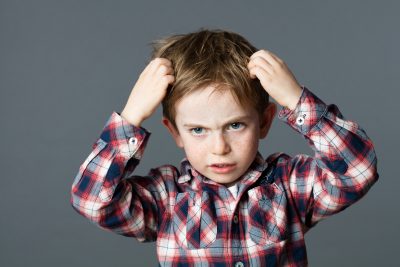If you suspect a lice infestation, it is important to understand how to recognize head lice.
Head lice are tiny, wingless insects that live on the human scalp. They are about as big as a strawberry seed (adults).
They are bloodsuckers—just as mosquitoes are. However, unlike mosquitoes, lice cannot fly or jump from one person to another; they can only crawl (very quickly). You don’t usually see live lice crawling around the head.
First Thing You’ll See
The first thing most people see are the empty nit or egg cases and they describe them as “tiny white specs that won’t move” similar looking to dandruff.
The nits that are “white” in appearance are actually empty egg casings. Nits when they are laid and viable (have a bug inside of them) appear brown in color.
People often say that head lice pictures on the internet don’t look like anything like the real thing.
These head lice pictures are magnified so that you can see what the lice bugs & lice eggs are also known as nits look like.
To the layman person nits and lice eggs are the same thing, in the scientific community lice eggs are viable (have a bug inside of them getting ready to hatch) and nits are empty egg casings. Whatever you want to call them – it’s best to remove them all.

Symptoms of Head Lice
Get the peace of mind you deserve and schedule a lice screening either in our lice treatment center or we do house calls!
The only symptom of head lice is an itchy head (or sometimes the sense of something crawling around) and for some people this is not the case.
Some people don’t show any symptoms of head lice.
I’m not Itchy?
Many people don’t itch because they are not allergic to the saliva the lice inject that makes us itchy.
Similar to a mosquito bite. In the event you have lice and aren’t itchy it’s usually at least week 4 before you detect them as they will begin to fall out of your hair.
The lice bug itself only has a life span of about 30 days. Get screened as soon as possible if you or someone you know is suspected to have head lice.
Understanding the lifespan of lice is crucial when devising strategies for prevention and treatment. Let’s delve further into the fascinating world of lice to uncover more about their longevity.
On the Host and Off the Host: When it comes to their lifespan, lice exhibit distinct behaviors depending on whether they are on a human host or off it. While lice can survive on a human host for approximately 30 days, their survival off the host is significantly shorter, typically ranging from 24 to 48 hours. This short window of survival off the host underscores the importance of targeting both lice and their eggs during treatment to prevent reinfestation.
Reproductive Cycle: The reproductive cycle of lice adds another layer of complexity to their lifespan. A female louse is capable of laying an impressive 3 to 5 eggs per day, contributing to the rapid spread of infestations. These eggs, also known as nits, hatch within 7 to 10 days, giving rise to nymphs. It takes an additional 7 to 10 days for these nymphs to mature into adult lice capable of reproducing and continuing the cycle.
Implications for Treatment: Understanding the lifecycle and lifespan of lice is essential for effective treatment strategies. Since lice eggs can survive for several days before hatching, thorough removal of both lice and eggs is crucial to prevent reinfestation. Additionally, targeting both adult lice and nymphs is necessary to disrupt the reproductive cycle and halt the spread of infestations.
Conclusion: In conclusion, the lifespan of lice is influenced by various factors, including their presence on a human host, their reproductive cycle, and their ability to survive off the host. By gaining insight into these aspects of lice biology, individuals can implement targeted and effective treatment approaches to eliminate lice infestations and prevent their recurrence. Remember, knowledge is power when it comes to combating lice, so arm yourself with information and take proactive steps to protect yourself and your loved ones.
Can Dogs Get Lice? Debunking the Myth
If you’ve ever wondered whether your furry friend could catch lice from humans or vice versa, the answer is a resounding no. Let’s delve deeper into this common concern to put your mind at ease.
Human Lice vs. Animal Lice: Understanding the Difference Human head lice, while notorious for causing discomfort and frustration among humans, cannot be transmitted to or from our beloved pets. The reason is simple: human head lice rely solely on human blood to survive. Similarly, dogs and cats have their own species-specific lice – dog lice for dogs and cat lice for cats – which are adapted to their respective blood types.
Why You Rarely Hear About Animal Lice Despite the prevalence of lice in humans, cases of lice in animals are relatively rare, and there’s a good reason for that. Unlike human lice, which are not indicative of poor hygiene or economic status, animal lice are often associated with unsanitary environments. In the United States, cases of animal lice are not commonly diagnosed due to the overall cleanliness and care provided to pets by their owners.
Putting Your Mind at Ease Rest assured, your furry companions are safe from the threat of human head lice. While dogs and cats can indeed get lice, it’s important to remember that they have their own species-specific parasites that are unlikely to be transmitted to humans. By maintaining good hygiene practices and providing proper care for your pets, you can minimize the risk of lice infestations and ensure the well-being of both your family and your furry friends.
Unraveling the Origins of Lice: A Tale as Old as Time
Ever wondered where lice come from and how they’ve persisted throughout human history? Let’s embark on a journey through time to uncover the fascinating origins of these pesky parasites.
Ancient Origins and Historical Evidence: Head lice, being human parasites, have likely coexisted with humans since time immemorial. Evidence of their presence dates back to ancient civilizations, with desiccated head lice and their eggs (nits) discovered on the hair and scalps of Egyptian mummies. Legend even has it that Cleopatra possessed a golden comb adorned with lice, showcasing their enduring relationship with humanity throughout history.
Insights from Scientific Research: Modern scientific investigations have shed further light on the evolutionary history of lice. DNA analysis of mitochondria from lice cells collected worldwide has revealed a common lineage dating back approximately 2 million years ago. This remarkable discovery suggests that lice have evolved alongside humans and can provide valuable insights into human evolution and migration patterns.
Adaptation and Resistance: As with any species, lice continue to adapt and evolve over time. In recent years, many traditional over-the-counter lice treatment products containing Permethrin have become less effective due to the development of resistance among lice populations. This phenomenon highlights the remarkable resilience and adaptability of these tiny parasites in response to environmental pressures.
Looking to the Future: Despite their resilience, ongoing research and advancements in lice treatment methods offer hope for effective control and management of lice infestations. By understanding the origins and evolution of lice, scientists can develop innovative strategies to combat them and minimize their impact on human populations.
Are Lice in My House? Debunking Common Myths
Curiosity about lice extending beyond the scalp often leads to questions like, “Are lice in my house?” Let’s debunk this myth and explore the reality of lice infestations in household environments.
Understanding Lice Behavior: Contrary to popular belief, lice don’t typically venture far from their preferred habitat – the human scalp. While adult lice can survive off the head for up to 24-48 hours, they rarely leave their host voluntarily. Lice may only disperse from the scalp if they’re dying or injured. Moreover, the life cycle of a louse spans just 30 days, minimizing the likelihood of lice establishing a permanent presence in your home.
Non-Human Surfaces and Lice: Fortunately, lice don’t inhabit non-human surfaces such as carpets, hardwood floors, clothing, furniture, sports helmets, headphones, or hair accessories. These environments are unsuitable for lice survival and reproduction. Therefore, the risk of acquiring lice from inanimate objects in your home is exceedingly low.
Taking Precautions: While lice infestations don’t typically extend to household surfaces, it’s prudent to take precautions if you’ve been confirmed with head lice. To help eradicate lice from your home, consider the following measures:
- Launder bedding, clothing, and linens in hot water and dry them on high heat.
- Vacuum upholstered furniture and carpets, paying attention to areas frequented by affected individuals.
- Seal non-washable items such as stuffed animals in airtight bags for a few weeks.
- Disinfect combs, brushes, and hair accessories by soaking them in hot water or rubbing alcohol.
Conclusion: In conclusion, while lice infestations are confined to the human scalp, it’s essential to take proactive steps to address them promptly. By understanding lice behavior and implementing appropriate precautions, you can effectively manage infestations and minimize their impact on your household. Remember, knowledge is key to dispelling myths and maintaining a lice-free environment.


Get Social